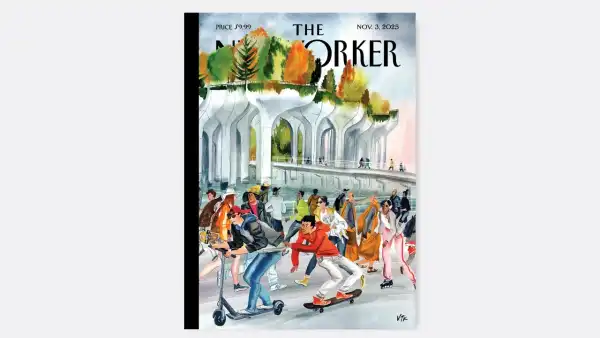
Thanks to hip-hop and Hollywood, the United States is still the world’s leading cultural exporter. But, in recent years, American culture has increasingly been following a playbook made in Japan. Consider the fascination with “the Japanese art of decluttering.” Its guru, Marie Kondo, lives in Japan. She generally relies on an interpreter, and it has been four years since she published a book in the U.S. While she has largely fallen off the radar in her home country, her popularity shows no signs of waning among Americans. One video of Kondo folding clothes, dubbed in English, has close to four million views on YouTube. On Valentine’s Day, Netflix sparked joy among fans with an announcement that it had greenlit a Kondo reality show.
Stripped down to its most minimalist outlines (an approach that Kondo would surely approve), a life of uncluttered simplicity represents a fantasy. Why should Americans be so compelled by one from Japan? Close to twenty years ago, the answer would have been “because Japan is the global imagination’s default setting for the future,” as the author William Gibson wrote in 2001. “The Japanese seem to the rest of us to live several measurable clicks down the time line.” Gibson was referring to a Japan of trendy gadgets and services, such as high-tech cell phones and robot sushi bars, the flashy products of a hyper-consumer metropolis that inspired the creators of such films as “Blade Runner” and “The Matrix.” But what Gibson wrote about products was just as true about other, less visible trends in Japanese society: economic stagnation; a plunging fertility rate; a dramatic postponement of the “normal” milestones of adulthood, such as getting married or simply moving out of the family home; a creeping sense of ambivalence about what the future might hold. Seventeen years later, America has finally caught up. We don’t buy into Kondo’s life-changing magic just because we think Japan is cool; we also buy because our country is, in many ways, increasingly like Japan.
A cynic would point out that the life-changing Japanese magic of tidying up is a ploy to divest ourselves of all the Walkmans and Tamagotchis and other tchotchkes that Japan convinced us to buy in the first place. But Kondo didn’t write her books for us; they were the product of a training seminar, a sort of literary incubator, for the Japanese marketplace. And she is only the most internationally successful of many writing on the topic in Japan. Kondo’s first book appeared at the tail end of a fad for things danshari—a Buddhist term for tidying up that is written with the characters for refusal, disposal, and separation—that swept Japan in the aughts. The first salvoes in what might be called Japan’s “war on stuff” date back even earlier, to the first half of the nineteen-nineties. That is when the sudden crash of the Japanese real-estate and stock markets ushered in twenty years of stagnation so severe that the period is now known as the Lost Decades.
Amid the suffering economy and the collapse of social safety nets such as the promise of lifetime employment, younger Japanese lost the ambition for acquiring things that fuelled an earlier, more financially stable generation. Hiroshi Aoi, the president of the Marui Group, which operates Japan’s largest retail chain, was uniquely positioned to see how drastically consumers cut back. In an interview in 2016, he told me that the Lost Decades represented a “turning away from outward expressions of fashion.… The idea of personal fulfillment became the product, with things like foods, dining out, and leisure experiences rising to the forefront.” If this sounds familiar, it is because the same pattern is now repeating among America’s millennials. Some call it the “experience economy.” Others call it “post-materialism.” But this great turning inward in the face of economic uncertainty could just as accurately be called Japanization.
“Japanization” (and the related “Japanification”) is a term as loaded as it is fluid. During the dark colonial period of the nineteen-thirties and forties, it evoked yellow peril, conjuring images of Japanese imperial forces conquering their Asian neighbors and compelling them to adopt Japanese ways. By the late nineteen-eighties and early nineteen-nineties, Japanization had taken on a wholly different meaning: “the diffusion of Japanese management systems and practices” in non-Japanese organizations, as the researcher Barry Wilkinson put it, in a paper written with Jonathan Morris and Nick Oliver, “Japanizing the World: The Case of Toyota,” from 1992. Two decades later, the word took on a sinister pall once again, at least among economic pundits. “Few words strike greater fear in the hearts of economists and politicians,” William Pesek, the author of the book “Japanization” wrote. In that book, he defines the term as a “a noxious mix of trifling growth, high debt, falling consumer prices, waning confidence, and political dysfunction.” (Paul Krugman, of the Times, is a fan of the term, frequently invoking Japanification in his descriptions of slowing growth and ageing populations in the U.S., the E.U., and China.)
If this sounds overblown, observe the fate of Toys R Us. When the seventy-year-old chain revealed that it would be shuttering all of its stores in the United States, pundits blamed a toxic combination of predatory lenders who had saddled the toy retailer with more than five billion dollars in debt, competition from Walmart and Target, and the rise of Amazon. But buried amid the laments (“I want to cry right now,” one customer told the Times) was a revealing comment from Toys R Us itself: One of the key factors retarding its growth was the country’s declining birth rate.
A drop in fertility is virtually a defining trait of industrialized economies. This isn't a bug; it’s a feature. Higher levels of education and access to reliable birth control make family planning attractive to citizens of developed nations. But, speaking purely statistically, a given nation requires a so-called “total fertility rate” of 2.1 births per woman to maintain its population. In 2016, the U.S. birth rate was 1.8, the lowest since 1976. For many reasons, Americans are choosing to have fewer babies, and, as a result, our population is growing steadily older. Framed in these terms, Toys R Us wasn’t a blip on the radar but a canary in a coal mine. Here, too, the U.S. is increasingly resembling Japan. One of the reasons that the Japanese have struggled to recover from their extended economic troubles is a basic lack of human resources. America has traditionally filled the gap with immigration, a history that hawks obsessed with “chain migration” and wall-building conveniently ignore. Japan’s population doesn’t have that source of replenishment. The country’s total fertility rate as of 2016 was 1.4, and the total number of births was the lowest ever in one hundred and eighteen years that records have been kept. As a percentage of its population, Japan has almost twice as many citizens older than sixty-five as the U.S. does. Adult diapers already outsell baby diapers there.
Another societal struggle that Japan was one of the first developed countries to encounter can be seen on the opposite end of the age spectrum, in its large population of unemployed young men and women. A report from 2017 revealed that, in 2015, there are some 1.7 million of them, a full ten per cent of those between the ages of fifteen and twenty-nine—a shocking number, given that Japan’s unemployment rate is an enviable 2.5 per cent. Officially, Japan calls these people NEETs (“not in education, employment, or training”) and “freeters” (temps who drift among various short-term jobs). The press has other, less generous terms for them, including “parasite singles” and “herbivore men.” In the early aughts, journalists spilled a great deal of ink on the herbivores’ seemingly unique lack of interest in moving out, getting married, or finding a girlfriend. One of the biggest domestic hits of the decade was the 2004 bestseller “Densha Otoko” (“Train Man”), a novel, then a comic and film, about an anime nerd who has never been on a date. He is coached into a relationship by the collective wisdom of 2chan, Japan’s largest anonymous bulletin-board system, which acts as a digital hive-mind Cyrano de Bergerac. At the time, some Western reviewers questioned its plotline: “Isn’t there something odd about a 22-year-old man being so utterly clueless?” the Japan Times asked.
Yet Japan’s trend is now America’s: a 2016 Pew study showed that, for the first time since 1940, men between the ages of eighteen and thirty-four are more likely to live at home with a parent than with a partner or spouse. Many lack college degrees. “So what are they doing with their time?” the University of Chicago economist Eric Hurst has asked. “The hours that they are not working have been replaced almost one for one with leisure time. Seventy-five percent of this new leisure time falls into one category: video games.” Not coincidentally, a field that the Japanese perfected, if not pioneered.
Tellingly, the Japanese have a slang term for people like this: otaku. Literally meaning “one’s home,” the word emerged in the early eighties as slang for young adults who eschewed normal relationships in favor of the virtual worlds of manga, anime, and early video games. At the time, there was a great deal of hand-wringing among academics and critics about a generation’s stubborn refusal to graduate from such juvenile entertainments into full-fledged adulthood. The critic Azusa Nakajima derided such people as “hermit crabs,” observing that “no matter where they go, they cart around tons of books, magazines, fanzines, and scraps stuffed into huge paper bags”—physical databases of the ephemera that they used to create their public identities. In what Japan calls its bubble-economy years, when high-flying investors were bagging international trophies such as the Rockefeller Center and Columbia Pictures, the otaku’s infantile, inwardly-focussed tastes became a societal embarrassment. “They were the polar opposite of what the mass media wanted to show in magazines and television,” the writer Tomohiro Machiyama, who published a best-selling book on the otaku phenomenon in 1989, told me. “In a certain sense they weren’t ignored, they were censored by the media.”
Yet when the bubble burst, in 1990, plunging Japan into its Lost Decades, this marginalized community proved a resilient incubator of trends. Chief among these was the Pokémon video-game series, whose creator, Satoshi Tajiri, is a self-proclaimed otaku. (“Everything I did as a kid is kind of rolled into one thing,” the then thirtysomething told Time in 1999: “Pokémon.”) That the geeky exports dreamed up by people like Tajiri retain their appeal today is a testament to the passions of their creators. But it’s also a testament to the fact that all of us now spend huge amounts of time the way they did: sitting in front of screens, rummaging through our own pop-culture databases, obsessing over our virtual identities while indulging in our own childlike pleasures, which range from the aughts fad for cupcakes to cosplay or the latest Marvel superhero flick. The resounding box office success of Steven Spielberg’s cross-cultural mash-up “Ready Player One” is only the most recent affirmation of a societal trend: we’re all otaku now. Japan was, once again, simply ahead of the curve.
I am an American who has lived in Tokyo for the past fifteen years. This gives me a particularly close view of the paradigm that the rest of the world, or at least its economists, seems so desperate to avoid. None would deny that Japan has problems. An ongoing nuclear-disaster cleanup from the Fukushima meltdown. A suicide rate that is one of the highest among industrialized nations. Political dysfunction so entrenched that it borders on pathological. A working environment that remains stubbornly hostile to career women and young mothers, even in the face of critical labor shortages. A never-ending state of tension with China and the Koreas, punctuated by the occasional wobbly flyover of a North Korean missile. And the problems of a super-aged society manifest in strange, sometimes heartbreaking ways: a recent report revealed the presence of a small but significant number of elderly citizens so desperate for human companionship that they turn to petty crime in a deliberate effort to land themselves in jail.
But, on the other hand, there are bright spots, too. Young adults, freed of the shackles of the older generation’s lockstep salaryman life style, report surprising levels of contentment. Public facilities and infrastructure remain in tip-top shape. The trains don’t simply run on time; they run faster than the trains almost anywhere else. The streets and schools are among the cleanest and safest in the world, even in the heart of Tokyo, the largest metropolitan area on the planet. There is almost universal access to high-quality, government-subsidized health care. And, while there are protests and demonstrations, some quite large in scale (a rally in April drew thirty thousand critics of the Abe administration to the national legislature), there is little in the way of the internecine strife rending America’s public discourse at the moment. What keeps Japan from flying apart, in the face of ongoing political, economic, and demographic uncertainty? A standardized national curriculum that insures a shared level of basic educational experience? An egalitarian pay ethic, with far less income disparity than there is in the U.S.? A refreshing lack of a 24/7 news cycle or televised punditry? Whatever the case, watching groups of visitors dressed like Super Mario zip around downtown in go-karts (a popular and increasingly controversial tourist pastime), it’s hard not to wonder if Japanization-phobes are missing the point.
Japan made itself rich in its industrial era by selling things like cars, TVs, and VCRs, but it made itself loved in those Lost Decades by selling fantasies. Hello Kitty, comics, anime, and Nintendo games were the first wave—“the big can-opener,” as the game designer Keiichi Yano put it. Now those childhood dreams haven given way to a more sophisticated vision of a Japanese life style, exemplified in the detached cool of Haruki Murakami novels, the defiantly girly pink feminism of kawaii culture, the stripped-down simplicity of Uniqlo, the “unbranded” products of Muji, and the Japanese “life-changing magic” of Marie Kondo. That these Japanese products are so popular, not only in America but in developed nations around the world, may indicate that we’re all groping for meaning in the same post-industrial haze.
If this is the end of the world, it is a happy end of the world, to borrow the title of an album by the Japanese band Pizzicato Five. The British writer John Lanchester summed it up in a column for the Times Magazine: “As Japan shows, us there are worse things for a society than calmly growing old together.” Or, to paraphrase Marie Kondo, all our futures, individually and collectively, depend on finding the things that spark joy in the midst of the inevitable, inexorable trend of old age. In the years to come, it’s entirely possible that Japan’s most successful export won’t be judged to be the Walkman or the Game Boy or the volumes of manga it churns out; it will be a helping hand born of its collective lived experience, just a few clicks ahead of us down the time line.
Sourse: newyorker.com






